Little Fears by Roland Jones
Introduction: There's No Such Thing as Monsters
Original SA post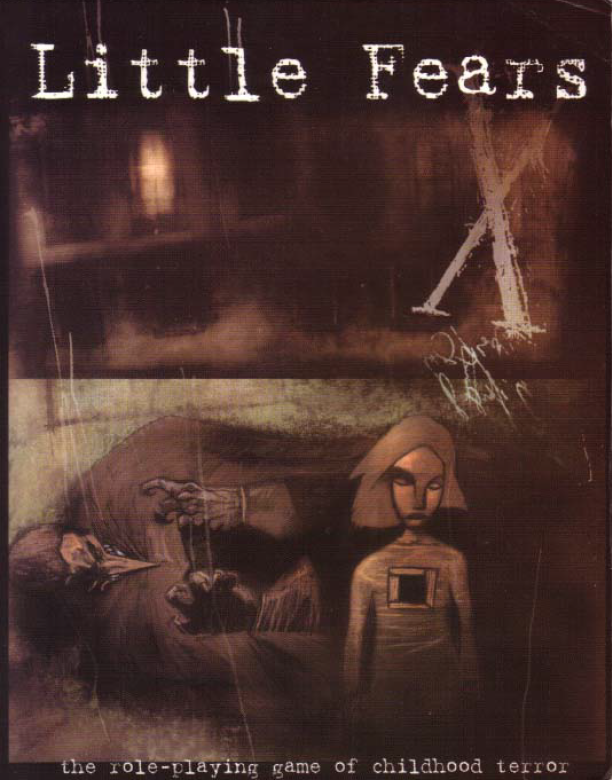
quote:
the characters and events
contained within are imaginary...
yet every day real children experience
horrors as terrible as what
is depicted in this game.
we at key 20 dedicate this work to
those lost, helpless children.
and we hope that you
will remember them always.
And before we even get to the table of contents, Little Fears establishes that this isn't going to be a happy game. Between the cover and the dedication, you only need to get two pages in to know that this is going to be dark . Which is good; when a game contains the things that Little Fears does, honesty's a good policy.
Speaking of honesty, on the page before the table of contents, one that lists who did what, there's a section entitled "little fears is a game of terror". It warns that some of the things contained within the book may be too harsh for some, and that anyone who is particularly disturbed by violence committed against or by children probably shouldn't read it. It's not bad advice, considering.
Anyway, let's get into the actual content here. Note that the version I'm using here is the original; there's also the 10th anniversary edition, which is mostly the same except with new artwork and updated rules. It's also a lot cheaper, since it's new rather than being ten years old and out of print.
Introduction: There's No Such Thing as Monsters
quote:
Somewhere, stowed in the far recesses of your mind, are all the memories of your youth. The first day you walked into school, your first birthday party, running around at recess and climbing the monkey bars, your first crush, memories of when you used to play out in the woods or in that abandoned building down the block... But deeper, in the furthest corners of your mind, are other memories. Memories that aren’t so happy. They’re buried deep, but if you try really hard you may just glimpse them. Memories of other things. Things that used to keep you up all night with your blanket over your head. Things that used to scritch-scratch at your window and call you up from your bed. Things that used to make you cover your face with your pillow or yell for your mother or father to come rescue you.
Look hard, you’ll find them
The book opens with a little bit of prose, addressing the reader. Right from the start, it's trying to get you into the right state of mind. Get you to remember what it's like to be a kid, and all the things that scared you then.
It then goes into a little bit of fiction, excerpts from a diary belonging to a little girl named Jenna. We quickly learn that her mother is dead, and her father drinks a lot and is abusive. This is actually delivered pretty effectively; she mentions it so casually, you know that it's just a normal thing for her now. Unfortunately this section isn't always up to this level; as a whole, the diary entries don't feel like something a kid wrote, with a few sentences in particular standing out, like, "He started yelling about how I always got in the way and how all he wanted was just to get laid (whatever that means)". Little kids don't write like this. Still, it isn't bad, really.
The next entry, we learn that Jenna has a monster in her closet. Not a cute, cuddly one, either; "I will have you, Jenna," isn't a particularly friendly thing to say to a little girl. Jenna is, understandably, scared, and stops sleeping in her room after this. Fortunately, she makes a new friend, a slightly older girl named Jessica who recently moved in down the street. They become pretty good friends.
Things don't go well for her for long, though; her dad comes home drunk with a woman and, pissed that his little girl is there killing the mood, locks her in her room. There, the monster is back, breaking her dolls and menacing her more. Utterly distraught, Jenna flees out her window to a local playground, falling asleep under the slide.
The next morning, she goes to Jessica's house, not wanting to go back home yet. Jessica's parents, as you would expect, are extremely worried to find this little girl in such a condition, and take her inside to get cleaned up; Jenna ends up staying the night with her friend. That night, she confides in Jessica about the monster, and, to her surprise, Jessica believes her. She tells Jenna about "Closetland", the place where the monsters come from and that adults can't remember anymore, where a monster that haunted her in the past was from. She had fought it off with her glitter wand, though; she gives this to Jenna because she doesn't need it anymore, having beat the monster long ago. Encouraged by this, when Jenna returns home she waits up for the monster, and when it arrives she beats it over the head with the wand until it flees, swearing revenge. (This is also our first look at belief magic, although the book doesn't tell us this; the glitter wand, as you may have already guessed, is just a toy. However, because Jessica believed it would work for her, it did, and because Jenna believed Jessica, it worked for her too. The belief of the innocent has power in Little Fears.) That night, she goes to bed happy, thinking her problems are over.
When she wakes up, though, and goes to see Jessica to tell her the good news, she finds a police car outside of Jessica's house. Jessica's parents tell her that last night someone broke into Jessica's room and hurt her, and that she's in the hospital now. Hearing this, Jenna cries; she thinks that this her fault, since Jessica didn't have her glitter wand anymore and the monster was mad that she beat it so it attacked her instead. She blames herself for her friend being hurt.
The last entry has Jenna telling her diary that she's decided to run away. The monster is after her, so if she isn't at her home anymore, then it'll come after her and it won't be able to hurt Jessica or Jessica's parents of even her father anymore. She's leaving her diary behind, so that they know that she isn't mad at them, and then she's leaving. Maybe she'll find a new mom and dad that love each other, and love her. Everything will be alright. Right?
After we hear Jenna's story, the book goes back to talking to the reader. It drops the statistic that, according to the FBI, over 2,000 children are reported missing each day, with 685,617 cases in the year 2000 alone. It also defines the two major categories these cases are filed under, and talks about how each year, these numbers, on average, go up. (It's a bit relentless, yes.) Its talk about the horrors children face segues into the source of these horrors. Adults can't remember it anymore; they know better now. It's ruled by a being known as the Demagogue, the source and product of fear. At its side are the Tormenter and the Seven Kings, who rule over the monsters of this place. Their goal is the destruction of innocence, the one thing that can hurt them, that burns them like a hot iron. This is why they haunt children, why they manipulate us and make us do terrible things to those we care about.
quote:
You have forgotten, haven't you? Suck a place, full of pain and torture, a haven for monsters, does not fit into your sane, rational world, does it? But the children haven't forgotten. They know it waits for them, that it hungers for them. And they have given a name to their darkest fears, the source of all their pain. They call it Closetland.
It is... a child's Hell.
(Sorry, the introduction was literally entirely exposition and prose. It's great to read, but it's not exactly easy to review for this sort of thing. It felt like it shouldn't be cut short and summarized, since even the weakest part is pretty good, but... I think I went a little too far in the other direction. Chapter one will be more like what we normally do here. Should be coming soon, since the main reason this one took so long was trying to figure out how to cover it effectively.)
Chapter One: To Be Young Again
Original SA post
Chapter One: To Be Young Again
After the crushing despair of the introduction, chapter one opens on a note that, while not exactly cheery, offers a glimmer of hope. As it puts it, "Little Fears is not about the child as the hapless victim, but the child as its own salvation." While most, if not all adults will dismiss their tales of monsters as childish fancy, rationalizing the scrapes and injuries they bear as the results of bullying and worse, your kids are not helpless.
Before getting into making your character, it gives you a bit of advice on getting ready to play your character. It describes the situation the kids are in (something's hunting them, no one believes them, they have to rely on themselves if they want to protect themselves and those they care about), and talks about assuming the mindset and demeanor of a child. It gives some really great advice here, too; I'm just going to reproduce it here because, well, it's just good.
quote:
Unlike a barbarian from the frozen waste or a 26ᵗʰ century mecha pilot, you actually were a child and you might worry about trying to act young enough and trying to capture being and 8-year old just right. Throw all that aside. Approach playing a child like any other role. Instead of donning a space suit, you put on a school uniform five days a week. Instead of seeking out the Dragon Lord, you run from the school bully. Instead of devoting your life to finding a mystical weapon, you're happy if you find an ultra-rare action figure. Instead of fighting in a war, you play war, squeezing the trigger of a mock gun and making "kapow" noises instead of launching 30-missile volleys at enemy spacecraft.
Before you attempt to fill the shoes of a child facing their nightmares made flesh, just fill the shoes of an average child.
It also lists places to draw inspiration from, such as the many movies that focus on child protagonists, and not just the horror genre. It also recommends checking out some children's programming, both to get into the right mindset and to get some examples of what children would actually know. Don't assume that children don't know anything; most children within the 6-12 age group the game focuses on will be literate and have basic knowledge of math, science, history, etc.
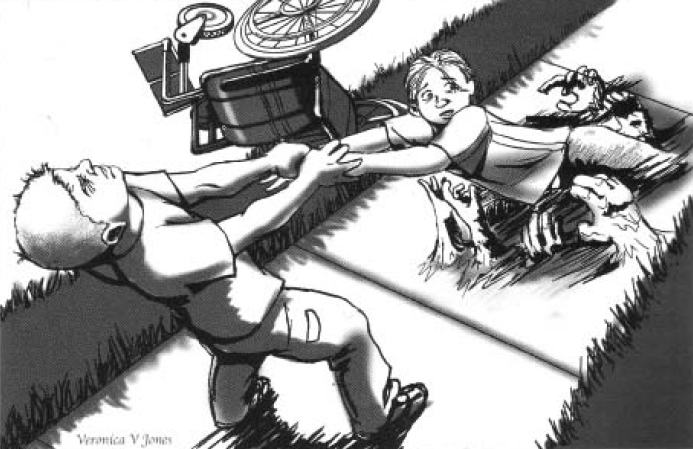
After giving this advice, it goes into actually making your character. The process actually is mostly filling out a questionnaire, which is what serves as your character sheet. The early questions are basic things, like "What is your name?" "How old are you?" "What color hair do you have? What color are your eyes?" However, it moves into other things that will help define your child a bit more. "Who are your friends?" "Which adult can you always talk to?" "What do you want to be when you grow up? Why?" "What is the most special thing that you own? Why is it special?" "What is your biggest fear?" "What do you do when you get scared?" "What is your homelife like?" As you may imagine, these questions serve a purpose beyond fleshing out your character.
After we have defined your child's personality and appearance, we move into mechanics. Each character has three major elements: Stats , Virtues , and Qualities , which are explained in that order.
Stats are, well, stats. Just like in every other RPG. In Little Fears, there are five stats: Smarts , Muscle , Hands , Feet , and Spirit . These represent your child's potential in these areas.
Smarts are intelligence, creativity, and such. Smarter kids have higher Smarts, to put it simply. Not all kids with a high Smarts will be straight-A students, though; some intelligent children are not encouraged to use their abilities or don't apply themselves.
Muscle represents strength, endurance, and physical ability. Strong kids and athletes will have higher scores here, while sickly children and kids who don't get a lot of exercise will have low Muscle. This stat is also tied to the game's health system.
Hands is the stat that represents manual dexterity and coordination. It is also the stat that is used for hitting things, if your child is the sort to do that.
Feet is speed, agility, and such things. Not just being able to move fast, but being able to move well ; ballet dancers and gymnasts will have high Feet scores, while those who trip over their own feet will have low scores.
Spirit is a bit different from the others; it's a mixture of willpower and attunement to ones Soul (one of the Virtues, which we will cover shortly), and is also tied to Fear. When something tries to scare your child, Spirit is the stat that will be used. Children who have an iron grit or who are in-tune with whatever they believe in (such as religion) will have a high Spirit. Those who are weak-willed, are push-overs, who believe that they are all alone in the world, will have low Spirit scores.
Virtues are less-tangible aspects of your child, and also are more prone to changing in the course of the game. They are Soul , Innocence , and Fear .
Soul is, well, how much of your child's soul they still have. It is entirely possible for them to lose part or all of it to the darkness of Closetland, a terrible fate indeed.
Innocence is your child's purity. Their openness and acceptance. It is somewhat like naivety, and children with a lot of Innocence are indeed frequently rather naive.
Fear is how much your child has been affected by Closetland, directly or indirectly. Fear induces instability, which only grows as your Fear rises.
Qualities are sort of interesting. While they don't directly affect your stats, they can increase or decrease your child's potential, and also cover things such as how other children and adults will treat them and purely roleplaying aspects of your character. There is a list, which will be visited soon, but other qualities can be suggested to your GM. Qualities are there to help further define and fortify the concept for your character, not hinder it.

So, we know what all the crunch for characters is. Now, we learn how to determine it all. First, every character gets six Playaround Points (PaPs) . All stats start at 2 and go from 1 to 5; they can be raised by one per point, or lowered for a point.
For Virtues, Fear starts at 0 and Soul at 10; Innocence is determined by age. A child who is six has eight Innocence, and it goes down by one for each year gained, with two points of Innocence to start with for a twelve year old. It may also be lowered (but not below two) for one PaP each, to reflect the life the child has been exposed to, or raised (up to ten) for two PaPs per point of Innocence, for children who are more sheltered or ignorant. Fear may also be raised by a maximum of two for one PaP a point. Soul may not be lowered.
Qualities either cost of give a point, depending on if they're positive or negative, but points gained from negative Qualities can only be spent on positive Qualities, not Stats or Virtues. The book recommends a maximum of ten positive qualities (and thus presumably ten negative since you don't have any reason to have more negative than positive), but the GM can raise or lower this number as they see fit.
Things I like about me
"I'm artistic." "I'm compassionate." "I'm popular." "I have an older friend." "I have visions." Positive qualities are the things your child likes about themselves, the things that aid them in their quest and that make them feel good about themselves and who they are.
Things I don't like about me
"I'm clumsy." "I'm mischievous." "I'm on medication." "I get picked on." "My family's poor." These are the things that your child is ashamed of, the things that hinder them in their day-to-day lives. They wish these things weren't true, but they are, and they are constantly reminded of that.
The dice mechanics in Little Fears are simple. Whenever your child attempts to do something, they either take a Test or a Quiz . Both use six-sided dice.
A Quiz is for actions that are not opposed by anyone else; doing a math problem, riding a bike, and so on. When taking a Quiz, the child attempts to roll under their relevant stat. Higher stats, obviously, are easier to roll under. (It isn't exactly clear if ties are a failure or not, although if they are then a stat of 1 cannot succeed on relevant Quizzes.)
If your child's action is being opposed, they instead take a Test . In a Test, you try to roll over your opponent's relevant stat, while they try to do the same for yours. Note that they aren't always the same stats; if something is attacking your child and you want to flee, your child would attempt to roll over their Hands score while they try to beat your Feet score. If both beat their opponent's stat, then the higher roll wins. If this is a tie, then either both are successful or it's a stalemate and you roll again.
Qualities affect your rolls here. If you have one or more positive qualities that would apply to the task at hand, you roll an extra die for each, taking the highest. If you have negative qualities that apply, you likewise roll the extra dice, but you take the lowest result instead. If you have both positive and negative qualities that apply, you take the difference and roll that many extra dice, taking highest or lowest as appropriate for if you have more positive or negative qualities.
Conflicts in Little Fears are resolved using the above rules; as you may expect, conflicts are usually Tests. The exception is when one of the individuals is unaware or otherwise unable to respond; in this case, the assailant rolls a Quiz. For dealing damage when you succeed in a Test or Quiz against someone, you take what you rolled, subtract the stat you needed to beat, then add weapon damage. This is how many points of damage are taken. After this, combat continues with a new Test until one or both parties quit, pass out, escape, or die. Some sample weapons include a pocket knife (weapon damage of 1), a large rock (3), a wooden baseball bat (4), and a pitchfork (5).
While no one wants their child handling guns, at least not until they're well past the age Little Fears characters are of, sometimes, firearms will enter the scene. Firearm combat is like other combat, and can be a Test or a Quiz. If the target is not moving, it is a Quiz against the wielder's Hands stat. If they are moving, then it is against the target's Feet stat. Note that guns are very powerful, with the lowest weapon damage being that of a handgun (10), something few children would survive. Meanwhile, there is no way that any kid would live though a shotgun being fired at them from close range (30).

Now, we've covered how damage is dealt, but we haven't gone over how much a child can take. There are five stages here, represented by five rows of boxes on your character sheet, each of which can take a number of damage points equal to your child's Muscle stat. This means that children start able to take ten points of damage total (two per row), while a child with maximum Muscle can take twenty-five. Wounds heal at a rate of two points per day, unless your child is feeling dizzy or worse. If so, then they only recover one per day until they heal past that point. There are also rules for first aid and intensive medical attention, taking the form of a slightly modified Smarts quiz on the part of the one administering assistance. The stages of damage are as follows.
"I feel fine."
When this row is the only one with points of damage in it, or your child has taken no damage at all, then they are still doing great and are in top form.
"I feel sore."
When boxes in this row start being filled, your child is feeling minor pain, but has still taken no serious damage.
"I feel bad."
This stage is where things start to take a turn for the worse. Your child's head throbs, they feel stiff, and they need medical attention. All stats take a penalty of 1, minimum 1.
"I feel dizzy."
Your child is close to passing out, they can barely move on their own. All stats are at -2, minimum 1.
"I feel nothing."
When this row is filled, your child dies.
There are also mechanics for when your child is confronted by the horrors of the supernatural. They must make a Fear Check , which takes the form of a Spirit Quiz, following normal Quiz rules. If they pass, then they control their fear. If they fail, then their fear takes over them; how they react can be decided either by relevant Qualities, the player or GM, or by rolling on a table. What happens after this depends on their reaction; for example, the child fleeing in panic may cause a Test as the monster pursues them.
Next time: We take a closer look at Virtues and how they affect our children, and finally see how the magic of Belief works.
Chapter Two: The Virtues of Childhood
Original SA post
(Update was delayed due to spending more time in town than I thought, catching a cold, and being distracted by things on the Internet. Sorry about that. This post was mostly written under the influence of said cold, so it's a bit... Well, I apologize in advance for it as well.)

Chapter Two: The Virtues of Childhood
Last chapter, we learned about character creation and mechanics and were horribly depressed by the game's health system. This time, we're focusing on a specific aspect of our children, their
Virtues
. Not just the rules behind them, but the concepts and the guidelines the game offers for them; the book itself admits that reducing things like a child's soul to a game mechanic would not do it justice, so GMs can use, tweak, or ignore the rules here as they see fit.
Speaking of
Soul
, that's the first Virtue we'll be covering. One's Soul is generally only lost due to Closetland's magic, as a monster from that place rips it out; a kidnapper can do many things to a child, but stealing their soul is not one of them.
The only way to restore one's Soul, short of going and physically taking it back, is through faith. Not necessarily faith in the Judeo-Christian God, but in some higher power, be it angels, earth spirits, or any other religion; the book refers to it as "some connection to a higher power or benevolent entity [to serve as] a leverage point for the soul to heal itself". Note, this isn't praying to some higher being to take the stolen soul back, it's the child drawing on what is left of their soul to heal the damage. It also does not preclude the possibility of what has been stealing the child's soul continuing its efforts to claim all of what remains. The book recommends a rate of healing one point of Soul per one to two weeks of concentrated effort.
As a child loses their soul, they undergo a process known as "the
Darkening
". This is one of the most horrific things Closetland can do to a child, drawing away at their very being. As their soul is consumed, the child weakens, physically, mentally and spiritually. They start to become unstable when their Soul drops to 8, but they truly begin to Darken at 6. Their skin becomes clammy and their pupils whiten, and they have trouble thinking, forgetting things as they say them. Should their Soul drop to 4, with over half their soul tainted by Fear, then they are truly in danger of being lost forever. Their skin pales to nearly pure white, regardless of its original color, they begin hallucinating and their speech is slurred, and bright light causes them splitting headaches. At 3, they develop a fever that can easily reach beyond one hundred degrees, and they are beyond medical help. At this point, they are almost certainly lost, for now the Darkening will spread on its own, without the aid of whatever was stealing the child's soul in the first place. This advanced Darkening causes a loss of Soul at a rate of one point per forty-eight hours. Should the child not be saved before their Soul hits 0, they are clinically dead. Their mind melts, their organs turn to dust, their soul, or what remains of it, is taken into Closetland to wander until a master claims it. Physical stats (Hands, Muscle, and Feet) will drop at a rate of one point an hour, while Smarts and Spirit fall to 0 immediately. There is nothing more that can be done; the child is lost.
The only way to save someone from the Darkness is to go to its source and retrieve their soul. If the one who has claimed is not stopped, the child is surely doomed. This almost always requires those attempting to save them to go into Closetland themselves and either killing or otherwise stopping the thief. If the thief is a King, then actually killing them is a nigh-impossible task; the children will have to figure out a way to trick them or otherwise retrieve the soul without directly facing the King. Is a lesser monster is behind the act, then facing them is possible, but still a very dangerous proposition. Should they succeed before the Darkening (or the original thief) completely claims their friend, then they can return the soul and save them.
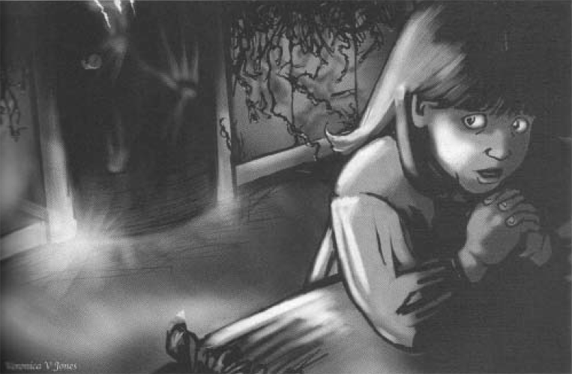
The next virtue is
Innocence
. Monsters will actively seek out children with high Innocence, to corrupt or otherwise destroy them. Those with low Innocence are generally harder for monsters to find, but are also less likely to be protected when they are in danger; both adults and greater powers tend to ignore them in favor of the more pure-hearted children.
Very few retain their innocence into adulthood. Almost everyone loses it before or at the age of 13, due to both its natural degradation and external events. There are many ways for children to lose their innocence.
Trauma is one of the most common ways a child can lose their innocence. Witnessing things like murder or rape can damage and traumatize anyone, even if they are mentally and emotionally mature. Children can't understand or rationalize these events, and it scars them deeply. Physical trauma, such as physical or sexual abuse, is among the worst, and can quickly destroy a child's innocence, in every sense. It's the worst when a child knows that what is happening is not normal or right, but cannot do anything about it. Those who grow up convinced that these things are a natural part of life retain their innocence, but face a far worse fate. The book lists some guidelines for the loss of innocence due to various events, and also, in an entire paragraph of bolded words, states that simply because there are rules for abuse, that does
not
mean that you should include it in your game. Do
not
use it unless you know your players can handle it.
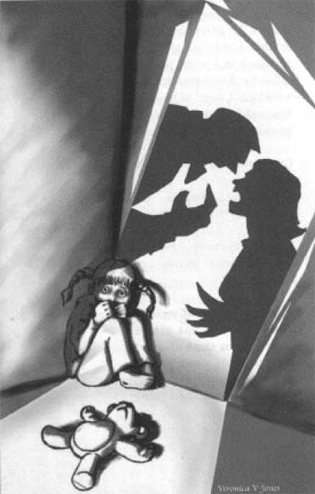
Sometimes, horrendous acts are committed by a child, rather than (or in addition to being) against one. Be it hitting another kid in a fit of rage or killing someone in cold blood, these actions are especially traumatic. Even when forced into action by an outside force, the blood, figuratively or otherwise, is on the child's hands. Mechanically, this causes twice the damage as a similar form of abuse; committing these actions is horrifically damaging, regardless of the circumstances.
Fear, meanwhile, is another way to lose Innocence. As Closetland eats away at the child's psyche, their purity is also lost. For every three points of Fear gained, a point of Innocence is lost.
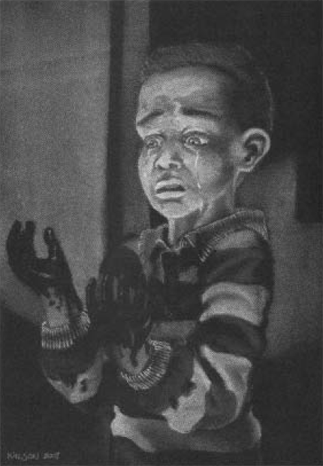
Finally, children lose innocence as they grow up, even without being exposed to terrible things. Every year on their birthday, a child loses a point of Innocence, until they turn thirteen.
Innocence lost cannot be regained, under any circumstances. The child's psyche has forever been changed, and they cannot unsee or unhear what they experienced. Even repressing the memories does nothing; any semblance of innocence regained is false, and will not heal the child in any way.
There is a reason that, at the age of thirteen, one stops being able to see the monsters lurking in the shadows, no longer aware of Closetland and its evil. In one's thirteenth year of life, the
Blindness
sets in. Children are able to see the evil lurking there, can fight it. They know the truth behind the mysterious disappearances, the strange acts of violence, even as their parents dismiss their claims. Then, one day, they wake up, and their world is different. They are Blind to the darkness, they have a rational explanation for everything that happens. The claims of younger children now seem silly. There's no such thing as monsters.
Those who lose their innocence before the age of thirteen are
Tainted
. Their minds have closed off to the outside horrors, and they are no longer affected by the terrible events they witness. However, this is far from a blessing; while they can no longer see or hear the evils lurking around them, they can still be affected by the horrors of Closetland. They simply rationalize what happens to them as an adult rationalizes all the horrors committed around them. Those Tainted may not see the monsters lurking around them, may put on a false maturity to protect themselves, but they can still be haunted, still be hunted.
Fear
is the last "Virtue" to be covered, and is the measure of how deeply Closetland has affected your child. Fear is the weapon, and essence, of Closetland; it was born if mankind's terror and grows more powerful as it spreads. Very few know no fear, and those rare individuals are detested by the Demagogue, who puts great efforts towards breaking such individuals.
Fear is primarily gained, as one would expect, through failing Fear Checks and the result being to gain a point of Fear (this is not always what happens). Some monsters, however, can attempt to directly inspire terror in a child, requiring a Spirit Quiz to avoid being overcome. Also, possession by a denizen of Closetland immediately causes the child to gain a point of Fear, which increases further every day they remain in its command.
Losing Fear is a difficult task, and not one the book covers in much detail. It suggest faith as one method, but apart from that, it says nothing. I assume this is being left up to the GM.
Fear can harm a child in many ways, but the most direct (and the one that is covered in the book) is madness. Filling a child with fear to the point of erratic behavior, insanity, or a psychological breakdown is something monsters love. It's the climax, the punchline. And all the horrors they've inflicted will be explained away as madness.
Mechanically and roleplaying-wise, Fear does not begin to have any significant effects until it reached 4, when they start to become unstable, which worsens at 5. At 6, they become deeply paranoid, and all actions are rolled with an extra die and have the lowest result kept, as if a negative Quality were always applied. Positive Qualities related to their mental state are ignored. 7, the paranoia intensifies, and they are certain that everyone is against them. 8, they start to demonstrate severe symptoms, such as violent behavior; the negative mechanical effects of madness are doubled, with two extra dice being rolled for all actions, taking the lowest. At 9, the child is as good as gone, with all symptoms of madness becoming increasingly severe. 10, and there is nothing that can be done; the Fear has consumed them.
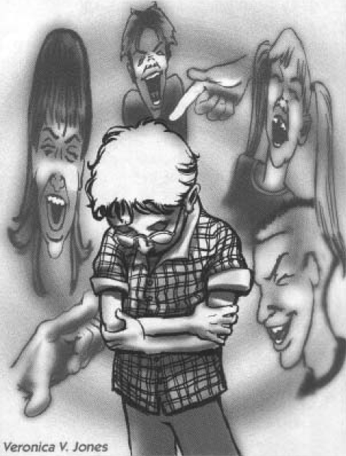
The children are not completely helpless, though.
Belief
can affect the world, for good or for ill, in ways beyond what is normally possible. Belief is tied to Innocence; Belief rolls are made with half the child's Innocence, rounded down. This is the number Quizzed against when attempting Belief magic. Belief rolls made after a failed Fear Check get a bonus die, as if there were a positive Quality in effect. The rush of fear and the impending threat have forced the child to belief that much harder.
There are two types of Belief magic. The first is
Material
, and as you may expect it is tied to objects that the child values or places importance upon. Their stuffed bear, their father's old flashlight, a locket containing a picture of a deceased relative. Unconsciously, a child invokes their protection and, through their Belief, may very well receive it. The bear could grow to eight feet tall and beat up the monsters. The flashlight could burn away the dark tendrils curling around the closet door. The relative's spirit may return to guard the child from the evil creatures.
When Material Belief magic is "initiated" the GM rolls a Belief quiz for the character. If successful, then the Belief magic works. After this, the player rolls for all actions by or relating to the item. Physical stats for items like the teddy bear are equal to half the child's Innocence, rounded down. Smarts and Spirit are that of the child, though. They also effectively have two positive Qualities active at all times, and do not use any of the child's Qualities related to their physical being (but still use the mental and spiritual ones, positive or negative).
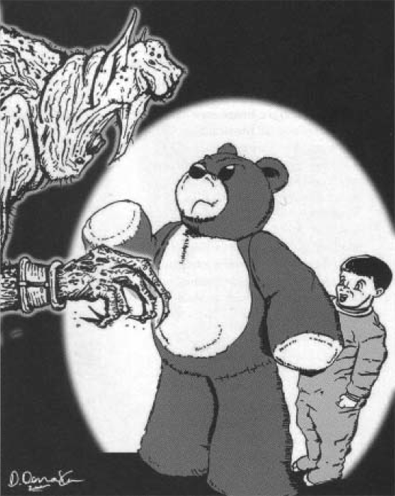
Yeah, not all the art in this book is great. Bit unfortunate that one of the few drawings that has things going arguably well for a kid has kind of crappy art.
The other type of Belief magic is
Incidental
. Little rituals, mantras, and other habits a child does to protect themselves or simply because. Walking around the bed three times before sleeping, praying when frightened, these things have power. When a child does one of these things, they make a Belief check. If successful, monsters attempting to harm the child must make a Spirit Test against the child's Innocence.
Incidental magic also accounts for things that should not work, but that the child doesn't know shouldn't work. The example used is a pair of X-ray glasses ordered from the back of a comic book; when used by the kid they would actually allow them to see through things. This type of magic is not strong, though. When it is used, the GM makes a Belief roll; if it fails, the item will not work that way again. Unless, that is, the child comes up with some explanation for the malfunction, such as the glasses not working in the rain or needing to be "recharged" every now and then; if the GM decides that this reason is good enough (and the book recommends being fairly lenient here), then the item can work again, albeit under these limitations.
Now for the ill I mentioned earlier. Belief is a powerful thing, and not everything a child believes is for their own benefit. Closetland works through Belief too, and can exploit all the silly ideas and superstitions in a kid's head. A kid steps on a crack, and the GM can make a Belief check; if successful, then their mother may slip and fall in the kitchen and sustain a nasty injury. Breaking a mirror or having a black cat cross their path could very well curse them to misfortune. Just as they don't deliberately invoke their Belief when bringing their stuffed animal to life to protect them, neither do they intentionally allow these superstitions to cause harm to themselves and those around them. It's an effect of the power of their Belief.
Belief magic failing can cause the child to lose their naivety, as they learn how the "real world" works. Under one's Innocence stat on their character sheet, there are ten boxes. Whenever Belief magic fails (the teddy bear hangs limp in the kid's arms as the monster approaches, the prayer does nothing to stop the monsters from coming in the night), one of these boxes is checked. When all ten are filled, the child loses a point of Innocence. (The book doesn't say if the negative effects of Belief magic failing can cause this as well. Personally, I'd rule that it doesn't; there is enough stacked against the players without you punishing them for being lucky.)
The chapter leaves off on one final note: Belief magic, while powerful, works on a small scale. It does not change the world. Whether being used by good or evil, it can't, at least directly, cause a huge catastrophe. One child's Belief will not alter the face of the Earth. Many children, though...
Next time: Tips and tricks for running Little Fears; it doesn't
have
to be dark and depressing! (It probably will be though.)
Chapter Three: Keeping the Kids in Line
Original SA post
Chapter Three: Keeping the Kids in Line
People who have been paying attention may have noticed that, unlike most RPGs covered in here, Little Fears didn't open with an "Introduction to Role-Playing" section like most games do. Since it's very unlikely for someone to start their role-playing career with Little Fears, I'm not going to hold this against the author, but it is an interesting choice; they went right into establishing the mood and trust the GM and players to know the basics of role-playing. Really, Little Fears is a very trusting game; basically the opposite of games like those made by Forge, it expects GMs to put their own spin on things and doesn't make hard rules for a lot of situations, like how we saw with the coverage of abuse and its guidelines for the mechanical consequences. This may tick off the grognard demographic, but I can agree with it; Little Fears is a game focused heavily on the story and role-playing side of the game, so loose rules work for it, and beside that trying to reduce things like abuse, emotions, or relationships to charts and statistics does not do the concepts justice and trivializes them as well. Anyone who wants exact values for how horribly witnessing a murder-suicide after being attacked by monsters (or whatever needlessly specific horrific situation) affects a child should find a different game to play, and possibly get therapy.
Anyway, my point, before I got a bit sidetracked, is that Little Fears does not open with a tutorial, instead working the "How to Role-Play" bits into the rest of the book as it's important. The character creation section, as we saw, includes some great advice for playing a child character specifically as well as role-playing in general, as well as advice like not to joke around too much; while it's important to have fun, horror is rather delicate and difficult to maintain, and the GM probably won't appreciate you shattering the mood. Meanwhile, the Test and Quiz section went over how a conflict would work with an example of a fight, showing both the mechanics working and how "I want to _____" and the narrative can be married with said mechanics rather easily. Now, we're at a whole chapter that's basically for the GMs, how to run games, how to maintain the right mood, and various other things.
Actually getting into the content, we start with it advising you not to approach Little Fears as if it's a horror game; instead, tell the story of a group of children and their lives. Go through a lot of the mundane stuff before entering the real horror. It mentions that this may seem boring, but compares it to role-playing, say, a barbarian in camp scenes like chopping wood or cooking food on the fire; it's not exciting, but "when the everyday is shucked away and something new and strange finds the character" is what makes role-playing what it is and makes it so compelling and exciting.
There's a little talk on how to approach horror as well. Its advice is to treat it as a sub-genre that is combined with another genre than a genre of its own. Its examples are the kids investigating why all the cats in the neighborhood are disappearing for "detective horror", or escaping Baba Yaga's kitchen as "survival horror". (We'll see more of Baba Yaga in the next chapter; she's something special.) It makes a comparison to other role-playing games here, pointing out that no one is ever playing just "fantasy"; it's "adventure fantasy", "political fantasy", and so on.
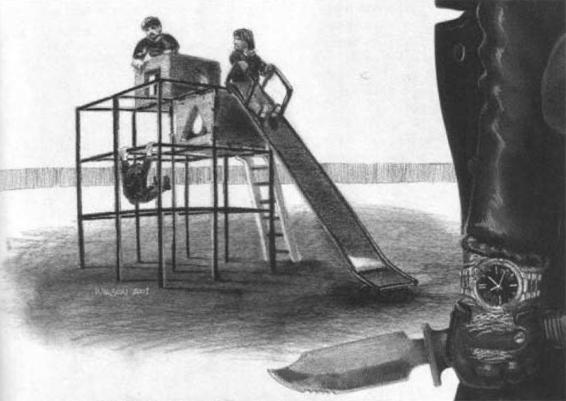
After the general talk, we get into more specific stuff. First, the various types of stories you can tell. The book presents three, all related to horror, but as you'll see when we go over some of the supplement adventures there are more.
The first are "Faery Tales", inspired by, you guessed it, old stories and such. There's a sense of wonder to them, but they can still be pretty dark. Hansel and Gretal, Little Red Riding Hood, they would be rather terrifying from the perspective of a child. Faery tales can be modern or set in older times; more important than the setting is the tone. "Faery tales flow and hte evil is slowly revealed." These types of stories are usually short, as one-shots or breaks in larger campaigns.
"Scary Stories" are not unlike faery tales, but rather than wonder, there is a sense of insecurity pervading them. The goal is to make the players think twice about things like entering dark rooms, and to make them feel weak and isolated. However, there also has to be a way out, a "light at the end of the tunnel"; the danger is real, but abstract, and the source is inhuman, making it removed from real life still.
"True Horror" is the third type of horror game covered, and as you might guess it's a bit more unpleasant than the earlier two. It actually isn't too different from scary stories, in many ways. It just removes some of the fantasy, and adds a human element to the evil. It isn't as "safe" as a scary story. There are two things that true horror really needs to succeed: First, the fear and discomfort must reach the players themselves, not just the characters; second, there is no safety net, no magic way to fix everything, the dangers the characters face are real. Both the characters and the players should be deeply affected by what happens. Obviously, this sort of game is not for everyone.
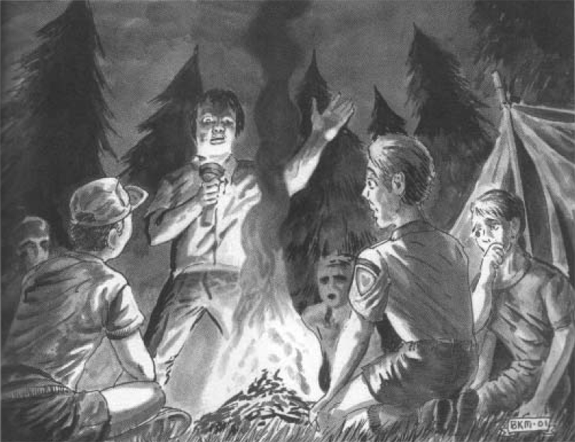
Now that we know what kind of story we're telling, we're going to look into how to run it. The book has some suggestions here too.
The first, and arguably most important, is to know your players. This will allow you to both get into their heads better by utilizing their real fears, and also so that you don't accidentally go too far. "A kind GM plays down to the lowest level of tolerance." Avoid things that you know your players have honest trouble with. If your group is up for facing darker things, though, then knowing them well will let you to use their phobias, taboos, the things they hate and fear, to make an experience that will really affect people and be memorable. However, the book again says that your entire group should know that this sort of game is coming and agree to it beforehand.
Good advice posted:
Springing the horror of child abuse on some unassuming player who spends $200 a week on psychiatric counseling to overcome the memories of abuse is just cruel. You're a grown-up, you should know better.
Really, it's hard to put it better than that.
After this, we go into a discussion of mood, and how to keep it consistent. This is a really long segment, so I'll try to stick to the main parts. The first bit, which is a very good piece of advice, is "[don't] let your players forget they're playing a game". Keep distractions to a minimum, and while some table chatter is alright it can ruin a game that's really meant to be terrifying, so be careful; the greater the intended level of terror, the more important the mood is.
It's hard to keep players from goofing off, the book admits, but it has some good tips. First, ignore unimportant non-game comments, as you drawing people further from the game won't help. Second, set the mood outside of the game as well: Ambient music, dimmed lights (but not so deep you can't read your character sheet), and props like old children's toys and teddy bears can all evoke the right emotions. It even recommends things like emulating certain things the characters are doing; a game of Candyland starts up, the players can actually play it while role-playing their characters, putting them both into the child's mindset and taking them off guard for when a monster pulls one of them under the table (in-game; the book notes that you shouldn't do something like that in real life).
More good advice posted:
On that note, when I say the players can imitate what the characters are doing, use a liberal amount of common sense here. They shouldn't go hunting monsters in the woods wearing pajamas with feet and Lazer Tag gear. Explaining to a group of campers that you're just "playing a game" could be a bit awkward.
Like I said, Little Fears trusts you to not be an idiot. It's rather refreshing, really, and despite the laissez-faire approach to both things like this and certain mechanics I think this book has one of the best "how to role-play" type sections and advice out of most RPGs I've checked out.
After this, we take a brief look at the GM-player relationship. Little Fears was written so that the players are as important to the story as the GM; the latter makes and controls everyone and everything the players don't, but the players have a lot to contribute too. The GM should be open to suggestions and improvisations from the players, and likewise the players should be open to those from the GM. They should be working together, rather than against each other; the GM creates the world and the possible adventures, and the players interact with it and pick up the threads they find interesting.
Seriously I can't not quote this it's just so good posted:
But there's someone at the table we haven't talked about : the dice. Those all-important, unbiased arbitrators of fate. Funny-looking polyhedrons whose sole responsibility is to decide whether you did or whether you didn't. Should what they say ever get in the way of telling a good story, ignore them. Or just don't ask them at all.
Don't be a dick, don't LARP, ignore the dice when you feel like? Little Fears isn't about childhood horror, it's a grognard's nightmare made physical. Really, even if you don't want to play the game I would recommend the general pieces of advice from this as reading material for a lot of gamers.
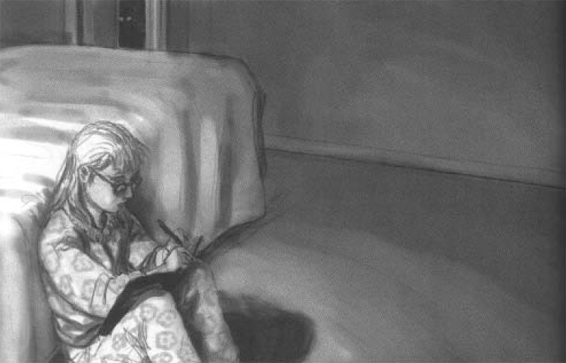
Now, remember the character creation process, and how it was basically filling out a questionnaire? As you have probably realized, this serves two purposes. In addition to developing the character, possibly in ways that a player wouldn't have considered originally, it gives the GM a good amount of material to work with. Things like "What is your biggest fear?" and "Who is your favorite person?" serve obvious purposes as tools for the monsters of Closetland to use to their advantage, but some are less obvious. "What is the most special thing that you own? Why is it special?" gives both a possible target for monsters and a possible focus for the child's Belief magic. "What do your friends call you?" is a way for the evil creatures to get even closer to the child, especially if they've taken over the body of one of their friends; alternatively, one of those monsters not using the name could be a hint to the characters (and players) that something is wrong.
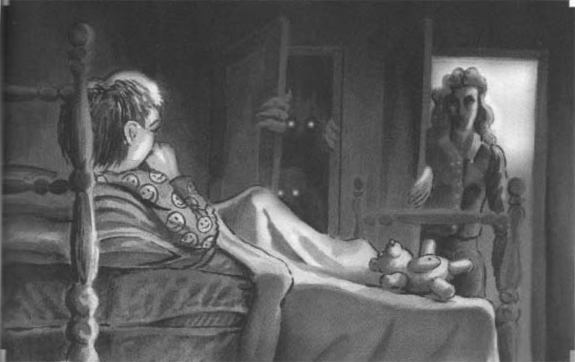
Something that attentive people may have noticed is that, while we've covered the children in detail, almost nothing has been said about adults. Here we get some important advice for role-playing them, as allies, foils, and adversaries. Consider how one's parents would react to the crazy stories, whether they'd scold them or pat them on the head while being sweetly condescending? Age and relationship to the adults are both important here. The advice for role-playing them is also useful, such as, for when a parent is serious, they do things like using the child's full name and different body language, demand that the child look them in the eye, and so on. It also includes how an adult can be on the child's side, like parents setting up "passwords" for when someone the child doesn't know tries to get them to go with them; if they don't use the right word or sign, the child knows that something is wrong. The biggest area that adults and kids differ in is rationalism, though; while children are innocent and can see all the monsters, adults are blind to it and will rationalize the terrible events that occur. As the monsters of Closetland use adults to do their bidding frequently, this is often further reinforced in many situations.
Mechanically, adults follow the same rules as children. Same stats, same one to five scale, same way Qualities work. Their main difference is that, at least before negative Qualities are applied, they roll two dice rather than one, as if they always have a positive Quality active. Also, while this isn't an explicit rule and would vary from character to character, all the sample adults have no stats lower than 3, while children all start at 2, implying a higher average stat. These two things alone make them a lot more capable than most children. Not all of them are against the kids, either.
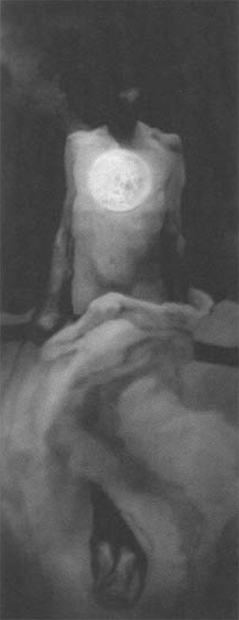
There is another force working on the side of the children, though. Something that guides children out of harm's way, that blesses children and tries to protect them from the darkness of the world. They are known as the Divine Host. They invisibly affect people's lives, although with children they can be more direct and even appear before them in physical form and speak to them plainly. What they are exactly is unknown, although they may be manifestations of hope just as Closetland and its ilk were born of fear. Ones named by children have even inspired various mythologies that have spread far and wide. The Host cannot save every child, though, for they are not that powerful yet (and of course the players and characters must be able to make mistakes), though one day they may be able to close Closetland for good. Their influence tends to be more subtle, creating fortunate coincidences and offering hints; in Faery Tales they may be especially prominent, being anything from a huntsman coming to slay the wolf to a fairy godmother, while in other stories their influence is likely to be less overt. There is, however, one thing they can never do, and that is directly oppose a monster. Closetland and its minions are too powerful, and not only would the guardian angel's end come quickly, but the power of the Host as a whole would be lessened.
Animals are another potential aide for the children; while some believe that the Demagogue trapped some members of the Divine in feral form, it is known fact that animals are very capable of detecting Closetland and its influence. Dogs are especially capable of such acts, with heightened senses and being able to see monsters even when they take human form, and while all but the largest beasts will fall to the hands of a monster, dogs will fight to the death defending a child they care about. Of course, monsters can take the form of animals, too.
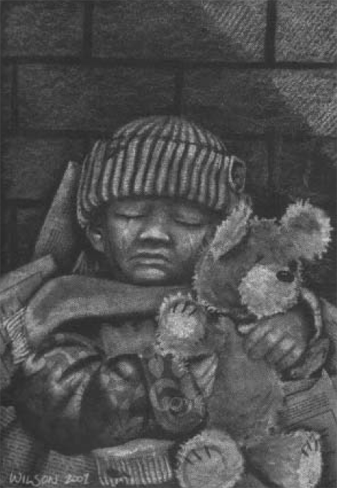
The last section of this chapter covers "hand-me-downs", which are basically artifacts. They're mystical items that may come into the children's possession, though sometimes they have been corrupted by Closetland. The book comes with four examples, but it advises you to make your own. They vary greatly as well; in order they are a sceptre that can release a light to burn any evil creatures, a ring that makes the punches of those wearing it hit like steel, a knocker that, when placed on a door, will open to Closetland rather than the normal destination, and a charm bracelet whose charms will each turn back the clock ten seconds when removed. They can basically be whatever you want for your story, although of course the usual pitfalls of overpowered artifacts should be looked out for here. Still, they can be rather interesting.
The chapter ends with some final advice on how to handle all this; I could sum it up but it'd be about as long as what's already there, so I'll just quote it for you instead. (Typos and grammar weirdness theirs.)
Tying It Altogether posted:
The hardest thing as a GM is taking all the elements we just went over and bringing them together into a compelling, involving, and terrifying story. It is also, to be cliche, the most rewarding.
The main thing is to not feel that you must use everything in this section in your game. Pick and choose the elements you want and mold them to fit what you and players look for in a good story. Everything in here is presented as a loose framework so that you do not feel confined by the rules. The single most important thing to remember as a GM is that everything is subject to what the story demands.
Next time: Feeling happy? I'm going to end that. We're meeting the lord of all Fear, his seven Kings, and the creatures that serve them.
Chapter Four: Behind the Door
Original SA post
Chapter Four: Behind the Door
This chapter opens with some prose about Closetland; while it's rather nice, you can go buy the book if you want to see it. The summary is mainly stuff we already know anyway, like that Closetland is the source of all fear, ruled by the Demagogue and his seven Kings, who hate innocence and spread evil and terror in order to destroy it. It's well-written, but we know it and I'm not copying a half-page of text here.
After reestablishing Closetland, we see how they enter our world. Closetland has many ways to affect the lives of those it preys upon.
The first, and the one many children fear most, is the Closet Monster. Not a singular entity, the Closet Monster is actually a legion of horrible creatures with near-infinite forms and abilities. Some are strong and will simply drag a child from their bed, into the hell of Closetland, while others will manipulate them mentally or emotionally, taking the form of friends and family or affecting their thoughts directly. Closet Monsters can enter our world through any door that leads to a small, dark, uninhabited place. Such as, say, your closet. This is by far the most direct way Closetland haunts its prey.

Sometimes, more than one monster of Closetland comes to our world at once. Sometimes, it overlaps houses or entire neighborhoods like a second skin. The effects of this can vary immensely, from the entire neighborhood becoming dark and dilapidated to the trail out of the woods leading in a circle as footsteps approach from behind. This only happens when a child is alone or with other children, never around adults; whether Closetland has truly invaded our world or simply the minds of the children who see it is unknown, but the effects it has on
children are real. Those who escape sometimes tell of the dark world merely fading away, while others had to convince what was holding them there to release them, with words or through trickery or force. Many, though, have no story to tell, for they never came back.
Besides closets, there is another form of portal the monsters can use to enter the real world. Shadows and other places of absolute darkness offer another route, although one less organized and trustworthy; the monsters cannot know exactly where they will emerge, for there is no set path through the shadows. Many monsters, though, hunting for the thrill of chasing down and capturing children, don't care about this.
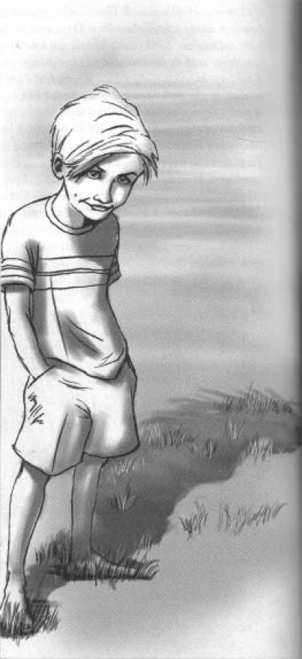
The last way that Closetland can affect our world covered here is, ironically, through one of the greatest assets children have against that very same darkness. Through Belief, the world can be changed in certain ways. This is not done by a lone child or group of children; rather, when an urban legend or campfire story gains too much traction in the minds of children, the force of their Belief will bring it into reality. Tales like dark things appearing at the stroke of midnight, a ritual to summon ghosts in a mirror, and other things children tell each other to scare their friends. These threats don't appear in Closetland, either; rather, they take hold in and menace the real world directly.
These and other threats sometimes necessitate that the children, rather than fighting off what horrors come to them, go into Closetland themselves to face it themselves. Whether to stop a monster that's been stalking them or to retrieve their lost friend, or merely to bring back a lost toy or just because, sometimes the kids will attempt to enter the dark halls of Closetland. Is this possible? Yes. Through the same power that lets children both fight the darkness that that can bring it to them, if the children believe in whatever ritual they attempt to gain access, they can find a way in. It may simply be "schoolyard hocus-pocus", but that sort of thing has power in Little Fears.
Harder than gaining access to Closetland is getting back out. Out of the infinite doors within, one leads back out. Another way is through the energy, the soul left by a slain monster before it return to the Demagogue to be reformed; if the child is within when the soul is reclaimed, though, they will be lost forever. Some other ways remain as well, such as through a mirror (while few mirrors in our world lead into Closetland, most mirrors there lead out, save for those in one place), or following a lost soul that has been trapped within that place of darkness. Whatever way they escape through, the process is not guaranteed to be easy, and the child will not always leave where they entered; they could exit across the street, across town, or across the country.
The interior of Closetland is difficult to describe, at least in terms of specifics. The structure is constantly shifting transforming, and a map of the area would be entirely useless. However, it is always a place of darkness, fear, and suffering, and it looks exactly as one would expect based on this. Its most common inhabitants are not monsters, but the souls of lost children. Regardless of whether they were good or life, thanks to the machinations of the Kings they are now forever trapped. Many have no awareness of their plight, merely going through the motions of what they did in life, but some have relatively clear minds that nevertheless do not enable them to escape. Others have their bodies roaming the darkness, with their souls taken by something deeper within, leaving them unable to return. They have been trapped for years, centuries, and most will never escape.
Of course, just because they are not the most common inhabitant does not mean that there are no monsters. There is a legion of dark beasts lurking within; their forms infinite, it is useless to try to describe them all. However, there are some creatures of particular note, the ones behind all the darkness and evil that pervades this place and that leaks through into our world.
The Demagogue
The lord of all fear, born of mankind's terror and proginator of all evil, the Demagogue is the one who created Closetland and started the war on innocence. No one knows his motivations or why he hates children so; even the monsters have nothing beyond speculation as to what he thinks. They just know that they must obey his every command, and they live in constant fear of he who knows all that happens in his realm. Even the Kings have no secrets from his ever-present gaze. He resides in the heart of Closetland, never seen by most, so while his influence is everywhere, most children do not even know of his existence. When he needs something done, he sends his servant Branxis to take care of it for him.
Branxis the Enslaver
Lord of the Labor Camp, Branxis is the Demagogue's right-hand man and the one who oversees the construction of Closetland, his master's kingdom. Those who labor under him are children, broken under his power and forced to work on tasks beyond those their young bodies are capable of. Most, when their use runs out, are discarded; those few that overcome their own weaknesses become half-demon Enforcers, tasked with watching over the other children of the camp.
Branxis, being the Demagogue's most loyal servant, has much sway in Closetland. He is regarded as more powerful, both politically and physically, than even the Kings, though this has yet to be put to the test. A terrible fate awaits the one who tries.
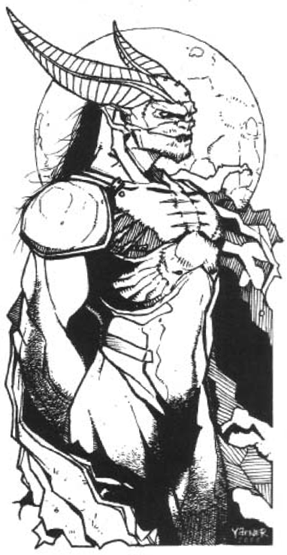
The Seven Kings
The Demagogue and his Enslaver hold the real power of Closetland, but they are not who children fear. So far away, most don't even know of their existence. It is those whose influence affects their everyday lives that they truly hate and fear. The Seven Kings, each one embodying one of Closetland's founding Aspects. While they rarely leave Closetland, leaving their tasks to their minions, they are the ones behind all the evil.
The Kings are all physically unsettling if not downright horrifying, but the real reason they are feared is their influence over mankind. Besides the legions they command, they can influence out even possess mortals, adult or child, breaking even their strongest convictions and driving them to commit terrible actions in the goal of furthering the King's agenda. The person possessed will likely have no memories of what they were forced to do, at most having vague dreams of themselves doing terrible things to a child that they would otherwise never even imagine themselves as capable of. Each time they are used in this manner, the darkness within them grows, making further manipulation easier and eventually driving them to commit evil without the interference of the King... Which, of course, brings the King even more power.
Warning: The following will get pretty disturbing, even by the standards of this review, the examples of people under the influence of the Kings (which will be within quotation boxes) especially so. People who are particularly sensitive to things such as depictions of abuse may want to skip the quote boxes, especially those of Wrath, Sloth, and Lust, if not this section entirely.
The Bogeyman: King of Greed
quote:
A trickle... and then a downpour. The rush of ebony wings blots out the sky. All focused on a single perch. The mass descends into the woods. Veins of black course through the browning foliage, the ravens' red eyes light up and they sight their gaze on you. Your muscles moving on their own, you turn to bolt. Three steps and you fall. Sudden weight on your back makes it impossible to move. You open your mouth to scream and gloved claws cover it. Warm breath in your ear. "Hush, child... I am all you have now."
The Bogeyman is megalomaniacal and power-hungry, making claims to things such as existing longer than Closetland and being more powerful than the Demagogue himself. Despite his delusions, though, he is frighteningly powerful and is responsible for the disappearances of more children than all the other Kings combined, and he is blamed for more evil than even the Closet Monster. He is a being of two faces; the ones most see and that is whispered about in the dark halls of Closetland is that of a frenetic and bloodthirsty monster that prances and grandstands about, causing pain and misery to children everywhere and even stealing from the other Kings. Beneath his mask, though, he is cold, calculating, ever-aware of the power every other King holds and every thing that could be brought against him, as well as every advantage he can exploit in his attempts to gain power and succeed the Demagogue. (That the Demagogue has a need to be succeeded would be news to him.)
His innumerable army consists of monsters known as the Bogeys. Made of shadow and lacking features, they move throughout our world unimpeded and can act at almost any time. Hiding in shadows, they pounce on their victims and fold their forms around them, surrounding them in darkness and pulling them directly into the Bogeyman's chamber in Closetland. He rarely uses humans as puppets, putting more trust in his Bogeys; however, when he does control a mortal, they truly become his puppet. They begin to think, act, and eventually even look like the Bogeyman.
While the Bogeyman has two sides, children only ever see one. The mask of grand ideas and fury, issuing great threats of horrible tortures to those he has captured. However, much of this is just words; not in the sense that he has any qualms about ending a child's life, but that, when required to do so, he simply does it swiftly and unceremoniously before continuing his plans.
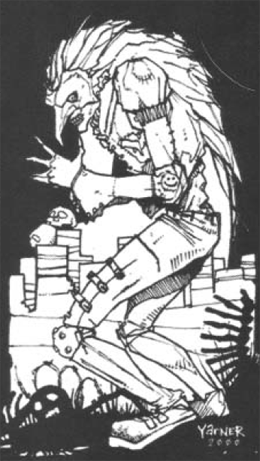
Titania: King of Pride
quote:
I don't know how it got this much out of hand. I can't even control it anymore. It's taken over my life. I'm just glad no one can hear me puking up. They just wouldn't understand. No one thinks twelve-year olds have anything to worry about. Especially this. She's so skinny, they say. But I'm so fat. They're just being nice. I just want people to like me. No one likes a fat girl... no one. But it's okay. I'll be okay. I just need to lose ten more pounds. Ten more. I'm almost there. Just ten more pounds... If I don't eat anything for the next four days, I should be fine. Just ten more pounds... and then I'll be fine...
Titania was not originally a creature of darkness, but one of light. Queen of Arcadia, of the faery, she blessed mankind and gave them gifts of joy and wonderment. However, the Null came, destroying her land and the faery within, leaving Titania alone. Without her kingdom or followers, she began to age and die, withering away. This is when she was approached by Branxis; serve as the Demagogue's paramour, and she would receive eternal youth and beauty and kingdom that would never die. Facing her own mortality, she accepted; however, there was another side to the deal. She would only remain young so long as she bathed in the blood of the innocent. Despite her revulsion, she did as she was commanded, disgusted by both her actions and those she had to witness. She began to die again, this time within her soul, becoming naught but a hollow husk. She no longer influences our world consciously, but her power remains great. Her minions still steal children to sacrifice for her, keeping her young forever, for if Titania were to die, so would her new Arcadia. And when Arcadia disappears, so will they.
Titania's new kingdom is not one of beauty and merriment, but of cold stone and malice. Her servants are the goblyns and redcaps. Goblyns are twisted green creatures, simple-minded in their pursuit of evil. Redcaps, imps named for the bright costumes they wear, are outright psychotic, as likely to eat a child as capture it. Both travel, not through shadows of closets, but clocks; any clock large enough for them to fit through is a portal to our world for them.
Those whose lives have been lost in preserving Titania's eternal youth have their souls trapped in the Hall of Mirrors. Looking into one of the mirrors there would reveal the soul of the child trapped within, pressing their hands against the glass and begging to be released. Some say that breaking the glass would free them; others claim that it would destroy the child for good. No one knows the truth but Titania, who has not spoken in over 4,000 years.
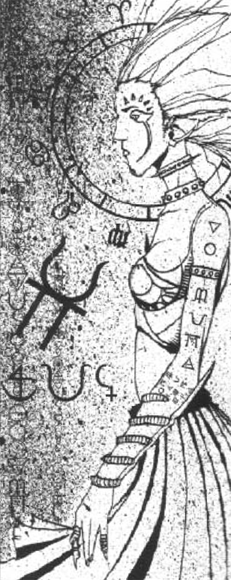
Rael-schol: King of Envy
quote:
There's this girl, Jessica Allman, in my class. She's ten years old and already she's showing. I am so jealous of her. All the older boys are always talking to her. And her mom always takes her out to get make-overs and, of course, she's always talking about it... No one even sees me. No one would even notice if I was dead. I bet they would if Jessica wasn't around anymore... I bet, I bet if Jessica was ugly no one would notice her. Spoiled rich, little... I bet if I cut up her face, people would like me then. People would notice me then. I bet if I burned her so bad that you couldn't even recognize her that then I'd be popular. Yeah... I'm gonna burn her pretty little face right off...
Unlike all but one other King, Rael-schol has only been outside of
Closetland once. The only success of the Demagogue's attempts to create evil children of his own, he originally served Branxis, torturing children in the Labor Camp. However, he became defiant, and sneaked out into the world; here, he saw children laughing and playing, something he himself had never experienced. He began to hate the Demagogue for creating him fully grown, for creating him at all. He longed to be young, to feel joy, to look at the world with awe rather than contempt, to experience all the things he had never felt. Jealousy was born within Rael-schol, and his influence burst out into the world with such force that the Demagogue, despite Rael-schol's hate for him, made him a new King.
Rael-schol's domain is a nameless tenement building, run-down and populated with monsters. Its master is too busy, consumed by his hatred and envy, to properly rule over it. The walls of his throne room are covered in the faces of the children he captures, torn from their bodies. Their spirit remains within them, voices faintly pleading and faces still bearing the pain of what they felt. Some shed tears of blood. Occasionally, Rael-schol will take down one of them and wear it as a mask, parading through Closetland in an attempt to relive what they felt, something that never works.
Rael-schol has mutilated his own form in homage to childhood; his body is decorated with scars and tattoos, a checkerboard on his back, the numbers from one to twelve on his hands and feet. Despite his appearance, though, children feel at ease around him, feeling pity when they see the longing in his eyes. He is in complete awe of children himself, allowing them to speak for as long as they desire about anything they want. He will listen intently, memorizing their words so that he can later attempt to use what they told him about, where they've been and what they've done, in his own fantasy attempts to relive childhood. Eventually, though, his jealousy will burst through, and he will pin the child down and destroy them, peeling off their face as the hate he feels for his father is directed at the child, and thus a new mask is created.

Lamashtu: King of Wrath
quote:
Damn kinds. Always getting into my things... I told them a thousand times to stay out of this room. Did they listen? Hell no. Next time I see them I'm going to kick the living shit out of them. They can't obey a simple fucking order. None of 'em. Dumb bastards... that's it! Where are they? Kyle! Were you in this room? Don't lie to me, boy, everything's moved around. I told you and your dumbass sister... don't smirk at me! C',mere! You wanna smile? I'll give you something to smile about! How about this? Huh? Don't you start crying on me, baby! Are you a baby? Huh, are you a little fucking child? Don't even try to run away, boy! The more you fight, the worse it'll get!
Titania's failure as the Demagogue's paramour necessitated Branxis to continue his search. After several centuries, during which he almost gave up, he eventually found something within fallen Babylon: The child-eating demon Lamashtu. Completely monstrous and utterly insane, she was brought by Branxis before his master; the Demagogue so approved of his discovery that Branxis was promoted beyond the status of King. While she was originally feral, the Demagogue molded his bride into something far worse. She is now elegant and charming, and yet completely brutal. Her influence causes people to sink into blind, misdirected rage. Abuse and neglect are her tools; children who've had their arms broken and ribs snapped for coming home late or not doing chores, who looked into their parents' eyes and saw a thirst for blood, they have all felt Lamashtu's touch. She has no purpose, no rhyme or reason to the pain she causes; she inflicts misery and suffering for the sheer satisfaction and joy it gives her.
Lamashtu's domain is modeled after her old home of Babylon. Full of gold statues, jewels, and other opulence, she sits at the center on her throne of rock and bone. She keeps many children as pets, chained and leashed around her domain as servants and recipients for her aggression. Not a single other King regards her favorably or is on her good side, for she is obviously favored by the Demagogue. Even when she committed the unthinkable act of slaying a fellow King, the original Defiler, she barely received a slap on the wrist; the other Kings are sure that, had they done the same, they would have been utterly destroyed. This act is also what caused Branxis, for the first and only time, to question his devotion to the Demagogue.
When speaking to children, she induces a strange sense of both calm and discomfort at first, bringing to mind one's mother or teacher. She begins by speaking clearly and calmly, but actually subjects them to horrible mental and psychological torture with her words. As she goes on, her speech grows louder and faster, until she is eventually screaming at the child, who lies broken and whimpering at her feet. When she controls someone (which she does often, for she enjoys watching as much as participating herself), their mood can be more volatile than her own. Her favorite puppets are those the child is closest to, for the shock and terror caused by the resulting outburst is all the more horrifying and damaging. When Lamashtu relinquishes her control, the subject frequently recalls the horrible things they did and said and are reduced to tears. This amuses Lamashtu all the more.
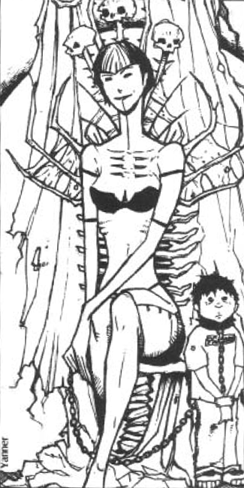
Kabaelza: King of Sloth
quote:
Lazy child. I come home from work everyday and this place is a mess. I remember school. School isn't hard. She could help out around here. What?! Where do you think you're going? No you're not. Not until you clean up your... what?! You come back here. You come back here right now! Come... back... here... Stop! Stop crying! You wanna get smacked again? Do you? Fine! Is this what you want? I don't care if it hurts! It should hurt, you lazy sonofabitch! Get in this house before I give you something to cry about! I work hard, you know! I don't need this from you! Now get your ass back inside and clean! I want this place absolutely spotless or I'll beat you so hard, you won't be able to stand!
Born of the Demagogue and Lamashtu, Kabaelza was raised by monsters without the care of either of his parents. His body grew to immense dimensions, but his mind never aged a day. Full of infantile rage and completely self-centered, the bastard of Closetland constantly stomps around giving orders; which are all obeyed due to fear of his father. Kabaelza's influence induces sloth, not just in the form of lethargy and laziness but in making people push others to serve them. From leaving one's baby in the care of their eight-year old sister to go out partying to forcing children barely beyond infancy to toil in sweatshops with machines that could kill them at any moment. Those under his influence also tend to become angry, if not outright violent, when their orders are disobeyed as well; the power of his mother, the King of Wrath, was partially inherited by him. His influence is unconscious, for he is neither intelligent nor aware enough to do these things deliberately, and he also cannot possess humans directly.
Kabaelza's "playpen" is at the bottom of a volcanic pit, with iron spikes jutting from the floor and pools of lava boiling over. The high walls of the pit trap all within, preventing any escape, both his playmates and the King of Sloth himself. He is frequently given children who are no longer of use to the other Kings, in an attempt to lessen his anger or at least keep it on something other than the monsters. They rarely last long, tough, before they are broken in both mind and body, and the King of Sloth begins screaming again.
Kabaelza's mind is like that of an infant or a mentally disabled child. He is never satisfied and yet he does not know why; all he knows is that he is unhappy, and that it is everyone else's job to fix that. He can't or won't listen to any orders given of him or anything that goes against what he wants, and any disobedience will cause him to quickly tantrum. Any who upset him should flee quickly, lest they find themselves before his mother, should he not crush them first.
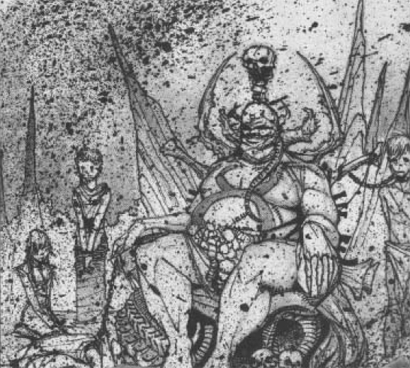
Baba Yaga: King of Gluttony
quote:
The minute I entered the house I felt sick. Poor Simmons lost it two steps in. The place was a mess. Ash and soot caked the floor, the windows were blacked, and the air was thick with the lingering scent of death. We caught a blood trail in the kitchen. It circled through a side room, through the bathroom, and up some stairs. Donovan spotted the burnt dress crumpled in the corner. We found the man gorged, unconscious on the floor. Browning blood all over his clothes. His eyes were glass, his skin pale and puckered. There wasn't much left of the child... poor girl. Most of her was in his gut.
The crone known as Baba Yaga was originally an ordinary human, an outcast from her village. Living on the outskirts of town and feeding on animals, one day she discovered an intruder in her home, a lost little girl. Inviting her into her home, Baba Yaga struck her over the back of the head then skinned her alive, eating her flesh and making her bones into tools. This act inflamed a great hunger within her; in the days that followed, she sneaked into the village at night and kidnapped children, making each last a day before going out again the next night. However, her appetite grew, until she could no longer simply make due with one child a day. Eventually, she was found out, and a mob burst into her house. There they found her sitting atop a chair made of human bone, boiling a freshly-skinned boy in her cauldron. Horrified and angry, they set her home aflame; as they watched, they heard her shrieking within, vowing revenge on them and all children of the world. Someday, all would feed on the flesh of the young.
The domain of Baba Yaga is known as the Butcher's Forest, a stretch of dead trees along the end of Closetland. Within the heart of these woods, her house stands on the legs of a bird. Within is "the Kitchen", a place of horrible torture and death. Hanging from hooks, stuffed into jars, boiling in pots, all around are the remains of children being prepared for her meal. Baba Yaga's influence in mankind controls gluttony, one of our greatest weaknesses. It is one that she manipulates in every way to exact her revenge upon the young. She drives people to cannibalize children, to leave unwanted babies to the animals, and to poison the food of our kids. She is making good on her promise.
Baba Yaga is a crotchety and angry hag. She is loud and controlling, yelling and banging pots and pans together to intimidate those she is speaking to. She loves to terrify her victims, tying them up in places where they can see their impending fate, such as inside pots next to boiling cauldrons or among her other "ingredients". However, she does not keep her prisoners long, unless she is intending to fatten them up; otherwise, they are eaten within hours.
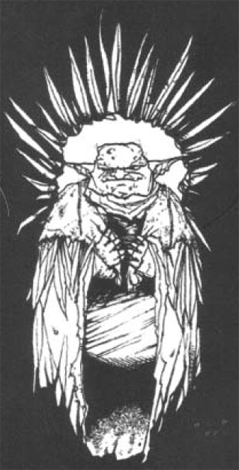
WARNING: I know I already warned people at the start of this bit, but the next guy is really something horrible. People who are sensitive to things such as sexual assault and sexual acts against children should NOT read the following section; if you wish to skip it, just keep scrolling until you get past the picture of the creepy smiling guy, where it says "Rules for Monsters". Don't read anything before it. I'm serious.
The Defiler: King of Lust
quote:
The man's bright eyes dulled. His baby blues flickered grey and focused in on the supple, virile flesh around him. He could smell their innocence and joy. Its sick sweetness coursed through his being, igniting long-buried desires. Sweat surfaced then trickled down his neck, making his skin uncomfortably moist. His heart skipped then the pulse intensified, filling his ears. The innocence, the naivete became repugnant. Consuming. He felt the heat build in his loins. He wiped the sweat from his lips as the children went down the slide. Cleared his throat and loosened his tie as his desire found the swings. The boy was young. Very young. And unattended... he was perfect. Young and beautiful and perfect...
The Defiler is both the most disgusting of all the Kings and the one whose influence children are frequently the most powerless to stop. He is different from every other King in that he does not employ any monsters or minions; he acts alone, personally corrupting each of his puppets, reveling in turning them into depraved monsters. He influences people into forming networks of pedophiles and pederasts, who do things from discussing their perversions and trading pictures to organizing meet-ups in real life to practice their terrible desires on new victims. He is extremely skilled in persuasion and manipulation, and he easily arranges for someone a child knows and trusts to fall to his horrible desires as a simple exercise of his abilities; however, he prefers a challenge, reaching into a good person and slowly twisting them into something abhorrent, eventually leading them out to search for the perfect prey, take them aside and gain their trust... And become the next story on the evening news. He takes his time, corrupting both parties involved in his sick game.
The Defiler's domain is known as the Playground. It is a schoolhouse and playground set in a cold, empty expanse. All possible playground attractions are there, from the swings and monkey bars to slides and jungle gyms and even metal animals on springs. Here, children play, their faces lacking any joy and their eyes blank and unfocused. The doors to the schoolhouse are chained shut; here, it is believed that all of the Defilers acts take place. That, when a child is subjected to him, they leave our world and are actually brought before him as he practices his craft, as they are dominated in not one but both worlds.
The book warns the reader multiple times against actually using the Defiler in their games unless you are absolutely sure the players are capable of dealing with him, something it does nowhere else in this chapter and rarely elsewhere in the book; for all the trust it puts in GMs, this is a matter it makes sure is known. Likewise, the section on actually role-playing the Defiler is the shortest of all the Kings, at most half the length of that of Kabaelza's, whose own is simply a paragraph describing how his mental limitations affect him. The Defiler is soft-spoken and constantly looking for weakness, twisting words to his own benefit. While he may get possessive if provoked, he is always in control, and has his goal at the front of his mind at all times.
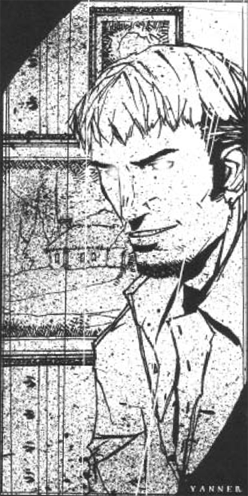
Rules for Monsters
While we have covered the most powerful beings in Closetland, for the most part, they are not who the children will be interacting with. Most of the time, they will instead be facing their minions, the monsters under their command. Now, we will be examining the rules governing how children face these terrible beings.
The idea here is both rather interesting and, sadly, somewhat flawed. As the book puts it, it's up to the children; whenever a child attacks, defends themselves from, or otherwise opposes or is opposed by a monster, they roll a Quiz, rather than a Test. They have to overcome their own fear and inadequacy; if a monster attacks a kid and they have to get a way (a Feet quiz) and fail, while it may appear that the monster got the better of them, it was the kid's failure that allowed them to be attacked. In fact, apart from damage modifiers for their "weapons" (claws, fangs, and such), monsters lack stats entirely.
While I like the concept here, there are a few problems. First, calculating damage taken as the result of a Quiz, based on the existing conflict rules, isn't really a thing that can be done, at least without some tweaking; damage comes from comparing the attacking roll to the opposing stat, subtracting it and adding weapon damage. Here, though, the only roll is that of the child, which, due to this being a Quiz, is less than the relevant stat, rather than greater than it. I suppose you could just use the damage of the weapon used for however many wounds are inflicted, or some other rules tweak, but it's still something that should be worked out and stated in the book.
Likewise, since they lack stats, monsters also lack health; there is no rule on how many wounds they can take before dying. While at least one of the supplement adventures has a certain number of wounds that must be inflicted to fell the "boss", and certain monsters listen in the book have weaknesses that will end them immediately (silver for werewolves, a stake through the heart for vampires, etc.), this is really something that ought to be included in the original work. Do monsters have health, or do they die to one success? If the latter, then weaknesses are irrelevant and it's really hard to make any particular monster more dangerous than the others. If the former, well, nowhere do we get those stats, making it basically up to GM fiat as to when a monster actually dies (not necessarily a bad thing, but they should at least come out and say it). On the whole, it's rather confusing.
(A question for anyone who owns the Anniversary Edition: Do they fix this there? This seems like an important area for them to address, if not the most important, and I don't currently have the money to find out for myself at the moment.)
Anyway, when a monster is killed (however you decide that works), its body disappears into a mass of fear that returns to Closetland. Despite how "real" they are, they are still temporary manifestations of fear; while this means that, should Closetland fall, all the monsters would disappear, it also means that until that happens the Demagogue will continue taking the energy of fallen monsters and reform it into new terrors. And, as Closetland will never be stopped until fear is eliminated, this process is not likely to end any time soon.
After going over the rules for monsters, we get several pages going over various types of monsters that exist, for the purpose of using them in our games and such. The first is the Closet Monster again. While, as stated, there are many Closet Monsters, the book offers many abilities that they can possess. It also gives the interesting fact that the Closet Monsters serve no Kings, instead answering to Branxis and the Demagogue. They are also, as one may have gathered, responsible for Closetland's name. In addition to varied physical strengths they can also have various mental, mystical, or otherwise strange abilities; these must be overcome with a Spirit Quiz, or else. They include hypnotism and luring the child into a deep slumber, to things such as assuming the forms of those the child knows and entangling the child in anything around them, such as a blanket or pile of clothes, or possibly even thin air.
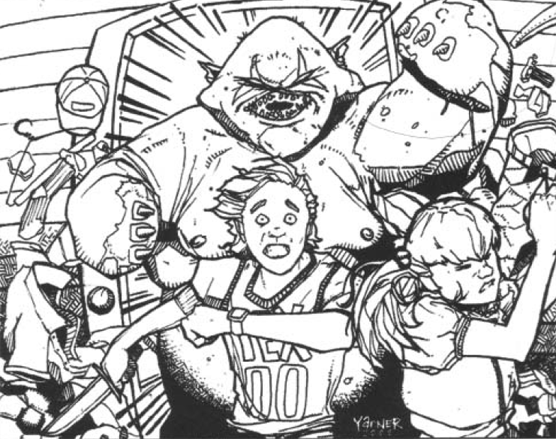
Next are the Body Thieves . This is a collection of monsters that, despite many different functions and origins, all do the same basic thing: assume the form of an exist child and "replace" them. They vary from living dolls to doppelgangers to the creepiest, the worms. A colony of worms squirming and writhing beneath the ground, they can come together and take the shape of a child; however, their transformation will be incomplete until they can take one thing from them to finish it: Their eyes.
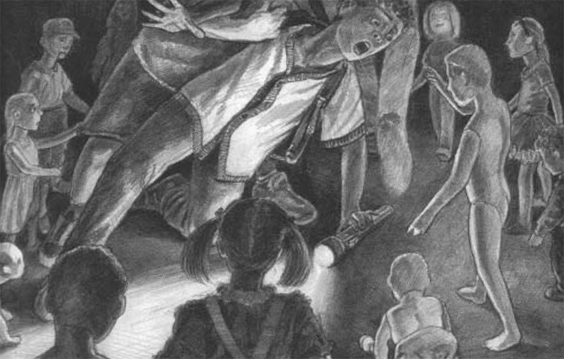
The third category of monsters covered are Everyday Monsters . These are "ordinary" monsters, such as werewolves, zombies, and vampires. There are some notable things here, however. An example is that ghosts and poltergeists are separate; while the former are simply spirits of the dead that cannot pass on and are not inherently destructive (many will seek the help of the children, although some are actively malicious), poltergeists are those who died in the service of Lamashtu and have been stripped to nothing but pure anger.
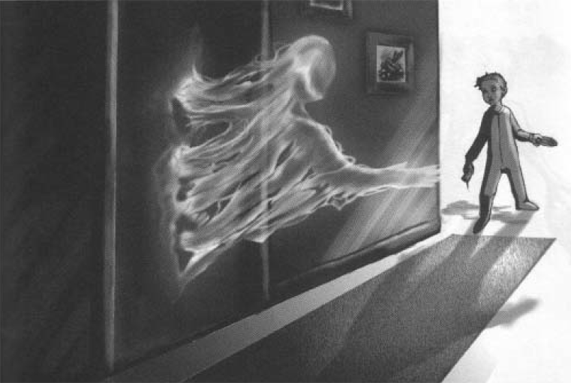
Some of the other "normal" monsters are different, too; vampires are twisted creatures with large heads and fangs rather than the dapper Transylvanians or sparkly goths most people imagine, although they possess many of the traditional weaknesses, including that they can be driven away by a symbol of any faith, not just a cross (this requires a Spirit Quiz, though, or else it will fail to repel the beast). Likewise, zombies are spiritless bodies that tend to wander one's basement or attic, rather than the product of a plague, and likely to wander away as a mindless being would be expected to, though should they be provoked they can be rather dangerous. Yetis, meanwhile, are non-aggressive, and may even aid the children, although that first requires the children to trust the large and scary monster. Overall, this section is rather interesting, and very useful if you want to run a more "normal" game, one dealing with more traditional monsters rather than the utter horrors of Closetland.
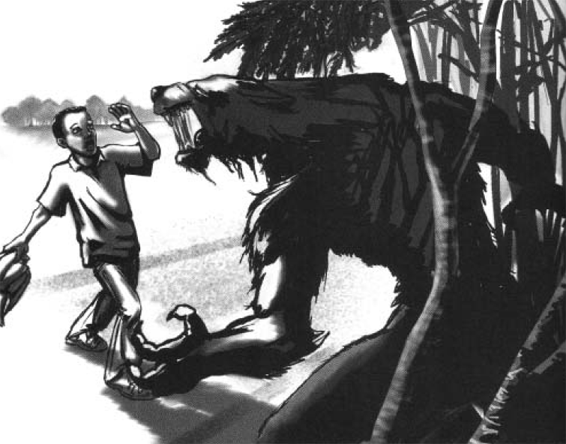
Next time: We finish up the book with a couple of sample adventures and quest hooks, plus a note from the author himself about how Little Fears came to be.